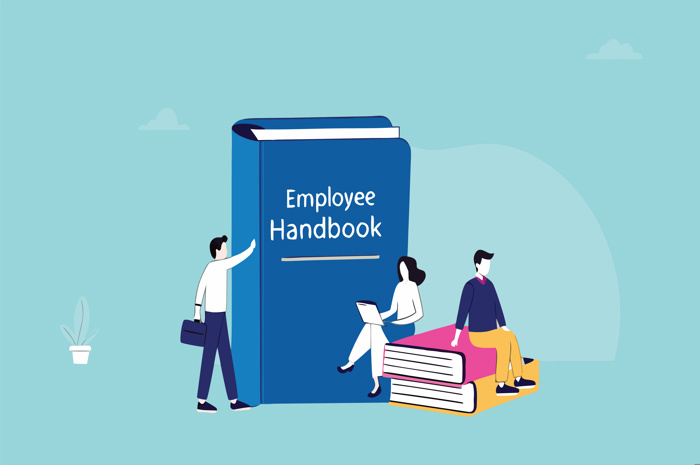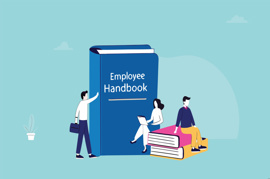What Is An Employee Handbook?
An employee handbook is a document that is created by an employer to introduce any onboarding employees to the company policies, the company values, its procedures and its expectations of all employee.
In layman's terms, it is a guide book for all new employees that simply and effectively explains the general information about the company that can be used to help employees with their day-by-day work life.
The content within the employee handbook would be applicable to all employees no matter what department they are joining or role they are filling, but it should be noted that an employee handbook is not the same as an employment contract.
Is My Company Legally Required To Produce An Employee Handbook?
The quick answer is NO! Employee handbooks are not legally required to be written and provided to employees, unlike itemised payslips and a written statement of employment that outlines the key terms of employment (pay and expected working hours).
If An Employee Handbook Is Not A Legal Requirement Why Write One?
A well crafted employee handbook can take some time to piece together but even a simple handbook can provide a business with many advantages. Some of the most notable advantages are:
Introducing employees to the company policies values and its mission
If all employees are presented with the same handbook which outlines from the get-go the values that are expected to be shown throughout the company then this can almost guarantee that every team shares the same values and are aligned with the company policies which can improve the company's performance all around.
Ensures employees are well informed of their rights and the benefits available to them
A good employee handbook clearly communicates to all employees the company policies comply with the employment laws they are governed and that protects the employees rights.
In addition to highlighting the company policies a good employee handbook will clearly highlight any benefits that are offered by the company and who qualifies for them. The most common benefits that may be included are health insurance and paid leave. If displayed properly this can then relieve the time spent on Human Resource administration as all necessary information can be viewed within the employee handbook.
Expectations of employees are well defined
Employers may have general expectations which are universal throughout the entire business such as dress code, when payday is, employees behaviour and the standard business working hours.
The employee handbook can then act as a reference at any point in time which means that the employer can take no responsibility for if an employee breaches the expectations as the document was readily available, therefore no one within the business should be uninformed.
Supports managers within your business
Within a thorough handbook managers can review how performance, reviews, disciplinary actions and other such factors of being a manager can be handled in a way that complies with the company policy without putting themselves or the employees in a less than optimal situation. Thereby directly assisting the managers in decision making and helping them to manage their teams more efficiently.
An employee handbook can protect the business from employee claims
The last of the most commonly recognised advantages to an employee handbook is how it can underpin the procedures that had been put in to care for employees but in situations where an employee makes a claim the handbook can confirm what company policies were in place at the time of the claim protecting both the employees and the employers.
How To Create An Employee Handbook?
Creating an employee handbook sounds like a daunting and time consuming task but it is easier than some would expect. It does not require any lengthy legal documentation, only the policies which the company should already have documented. Using our simplified guide below can help you piece together a handbook that protects both your business and your employees.
Step 1 - Create an Action Plan
Like with any important document, before any pen hits the paper (or hands hit keyboards), it is essential to plan what will be included within the employee handbook. Taking the time to create a clear action plan will help to:
- Reduce the time it takes to complete the employee handbook
- Prevent repeating content within the handbook
- Include all the required documentation
When creating your action plan you should think about what the purpose of your handbook is, whether this is for onboarding employees, sharing policies throughout the company or outlining the company's expectations. After deciding the purpose of the employee handbook you can then pinpoint who the audience will be. This will then help to decide the tone and the structure of the handbook.
By taking all of the above into account when creating an action plan can help towards the creation of a clear and concise employee handbook!
P.S. Try to hold back from using any technical terminology to ensure all users are able to understand the employee handbook in full
Step 2 - Collect the Key Documents
Now that you have created your action plan you can head out to collect the documents that you wish to include within your employee handbook. The documents that you collect would depend on your action plan created during step 1, although some of the most common documents included in an employee handbook are:
- A Company Overview - this would typically contain the mission statement of the company, it's brief history, it's values and possible a brief visual of the goals of the coming years
- Any Legal Requirements - these could be any documents outlining the laws that are applicable to the company (both employees and the company), the rights of the employees and depending on the industry of the company any compliance that is applicable
- Policies - any policy documents that outline information that is applicable to all employees. These commonly include the company policies covering general working hours, attendance expectations, allotted breaks, workplace attire and sick pay being the most common policies
- Benefits - details about the benefits that employees are eligible for throughout their employment at the company. Whether this health insurance available to employees, pension contribution details (retirement plans) or paid time off
- Company Specific Procedures - outlining the steps that will/should be taken for performance reviews, disciplinary actions or workplace disputes
Obviously, the types of documents above are what are typically found in an employee handbook but the documents included would heavily depend on your company and the sectors that it operates in. A construction company may be more focused on the health and safety elements within its employee handbook compared to a software company which would be more focused on its privacy policies and its GDPR.
Step 3 - Follow Your Action Plan and Start Your
You should now have a clear action plan and all the documentation necessary to start piecing together your employee handbook!
As you start to put pen to paper you may start to notice that your action plan was not perfect (which is more common than you may think) and that there is a more logical way to order the employee handbook to make it easier to read.
Whilst writing your handbook think about the following to ensure the content can be understood by all employees:
- Use plain English and short sentences to make sure the content is easily understood
- Where helpful use different visuals and formats to display the information to improve its readability. Examples of this could be the use of graphs, bullet-points, headings and other similar formatting techniques
- Using examples can help to provide clarity to employees when reading about more complex policies and procedures
Step 4 - Review Your Handbook
Once you are happy with your final version of your draft handbook its time for it to be reviewed to ensure it meets the desired needs of the company. Typically it is recommended that it is reviewed by an expert, whether this is a solicitor or a Human Resources specialist is at your discretion. The review would look into detail that the policies and the handbook itself complies with the applicable laws and regulations that the company must be compliant with.
During the review process the handbook should be subject to the typical review tasks such as looking for grammatical errors, typos or clunky wording.
Step 5 - Distribute Your Handbook
After the handbook has been reviewed and has the green light you can distribute it throughout your company whether this is digitally or a printed copy is up to you.
It is important that when you are distributing the handbook you require all employees to sign an acknowledgement form that confirms that the employee has received and read the handbook.




















